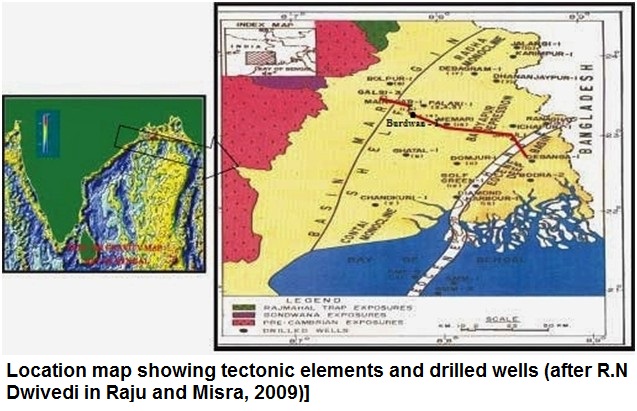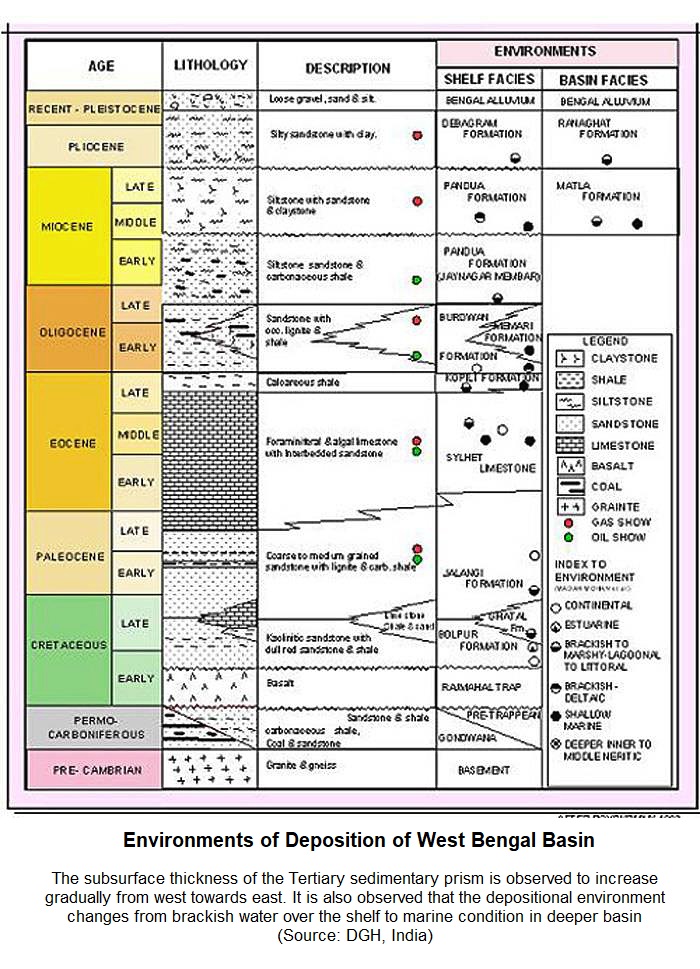Burdwan Fm
Type Locality and Naming
Type section is in the well Burdwan - 1, Interval is 1545-1675 m and thickness is 130 m. [Original Publication: Biswas et al., (1963) Results of exploration for Petroleum in the Western part of Bengal Basin, India. Proc. 2nd Symp. Dev. Petrol Res. ECAFE Mins. Res. DeVol. Ser No. 18, pt 1, pp. 241-250.]
Reference well:
[Figure 1: Location map showing tectonic elements and drilled wells (after R.N Dwivedi in Raju and Misra, 2009)]
Lithology and Thickness
Sandstone. The type section is characterized by the dominance of sandstone with varying grain size from coarse to fine and are occasionally feldspathic and lignitic. Few shale bands, lignitic shales (particularly in the lower portion of the Gold Green Member) and pyritic and microspherulites of siderite are common. Maximum thickness is 500 m in Golf Green area. Thickness of 163m in the well Burdwan-1
MEMBER(S) – The Burdwan Formation is subdivided into two members:
(i) lower Gold Green Member comprising of fine to medium grained, white, dirty white sandstone, light to dark grey siltstone and dark grey shale. At the bottom, a fossiliferous limestone band is also recorded. In NW Bangladesh, this Member is sometimes used as the entire Burdwan Fm.
(ii) upper Memari Member (sometimes separated as a Memari Fm in NW Bangladesh as the Upper Oligocene formation) comprises of grey to dark grey glauconitic, carbonaceous shale, fine to medium grained, occasionally glauconitic sandstone and a thin limestone band in the lower part.
[Figure 1: West Bengal Basin lithostratigraphy (after R.N. Dwivedi in Raju and Misra, 2009) with red-arrow showing position of this formation]
Relationships and Distribution
Lower contact
Lower boundary is unconformable with the Hooghly Fm (West Bengal Basin) or with Kopili Fm (NW Bangladesh) or Transitional to Cherra Fm (NW Bangladesh usage by USGS-PetroBangla, 2001)
Upper contact
Upper boundary is unconformable with the Pandua Fm, or possibly conformable with Diamond Harbor Fm.
Regional extent
Present in shelf, and NW Bangladesh (on Precambrian platform region)
GeoJSON
Fossils
In basin margin area, the Burdwan Formation is devoid of microfauna. Very few arenaceous foraminifers include Trochammina, Ammobaculites. Oligocene form Eulepidina is found in a number of wells. In wells like Maju-1, Golf Green -1, Chandkuri-1, Early Oligocene form Nummulites fichteli occurs along with Lepidocyclina. Oligocene planktonic forms like Globigerina gortanii, G. tripartita, G. ouchitensis also occur. By the evidence of palynomorphs the unit is placed in the Bengal Palynological Zone IV.
Age
Depositional setting
The Golf Green Member comprises transgressive deltaic sand. In NW Bangladesh, this unit is "freshwater deposits representing a regressive event of the Early Oligocene age in the Lower portion and by marine, or at least estuarine sediments indicative of transgressive conditions in the Higher ranges of the succession" (from National Encyclopedia of Bangladesh as compiled by several geologists; http://en.banglapedia.org/index.php/Geological_Group-Formation; 2015). The Memari Member not only includes transgressive but also regressive deltaic sand and shales.
[Figure: Environments of Deposition of West Bengal Basin (from dghindia.gov.in)]
Additional Information
Wells, such as Memari-1 and Ghatal-1, show the Burdwan Fm overlain by a Memari Fm, the second Oligocene stratigraphic unit." However, USGS-PetroBangla 2001 chart uses Diamond Harbour Fm instead for this interval (followed by Pandua Fm).


